There are more than 7 thousand varieties of succulents, but succulents with yellow flowers are the most striking for their majesty. They can give life to any space.
Succulents with flowers require some special care. In this article, I will show you the most amazing succulents with yellow flowers to have in your home. I will also give a brief description of how to care for these succulents.
Table of Contents
Florist Kalanchoe (Kalanchoe blossfeldiana)
Kalanchoe blossfeldiana is also known as Florist Kalanchoe is one of the most popular ornamental plants in its genus. It is usually marketed as a tiny flowering houseplant that comes in a multitude of colors, as well as single or double-flowered varieties. An ideal plant for decorating tiny spaces in our home.
Kalanchoe blossfeldiana is one of my favorite succulents with yellow flowers. The ideal temperature for development is 65 to 77 °F (18 to 25ºC), it is recommended not to place this succulent in places with temperatures below 50 °F (10ºC).
The natural flowering period of Florist Kalanchoe is from late winter to late spring. As with all succulents, it is best not to overwater and to use a well-drained substrate. Learn more about how to care for Kalanchoe.
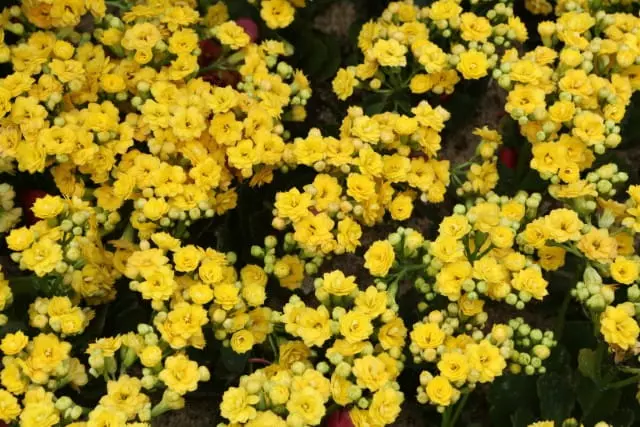
Christmas Cactus (Schlumbergera)
This succulent blooms during the winter to coincide with Christmas. It is not for nothing that the Christmas cactus is a favorite plant for those who want a touch of color indoors. The Christmas cactus is available in different colors such as red, pink, violet, yellow, and others colors.
Its scientific name is Schlumbergera, and it comes from Brazil. This succulent with yellow flowers can reach a size between 10” and 14” (25 and 35 cm). It belongs to the succulent family and is very resistant.
Years ago, I was given a Christmas cactus as a gift and what I liked most about this succulent is that it is very easy to propagate. I recommend our article about Christmas cactus propagation in water.
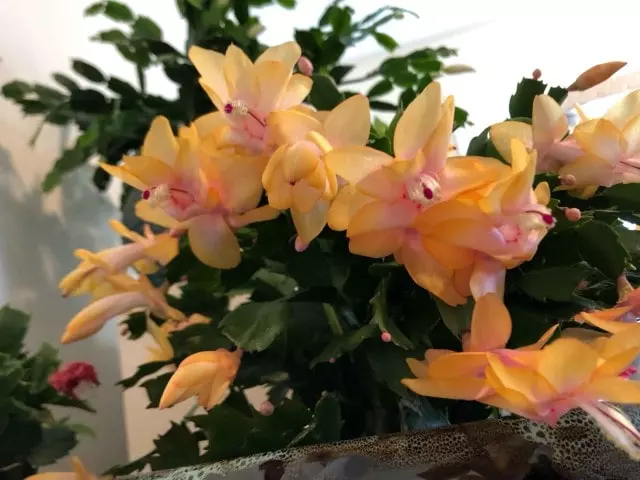
Sedum palmeri
Sedum palmeri is a succulent plant with simple care and very attractive rosettes. Perfect for any home garden. It is a succulent plant native to Mexico and naturalized in Italy common in rocky areas.
The plant has a shrub-like appearance with slightly flexible stems on which grow rosettes formed by fine succulent leaves. The oval leaves are pale green, although they turn reddish at the tip in the cold of winter and under excessive hours of sunlight.
This is another beautiful succulent with yellow flowers that you can have in your garden without many demands on soil and watering. Flowering occurs in late winter and early spring, giving rise to tiny yellow star-shaped flowers.
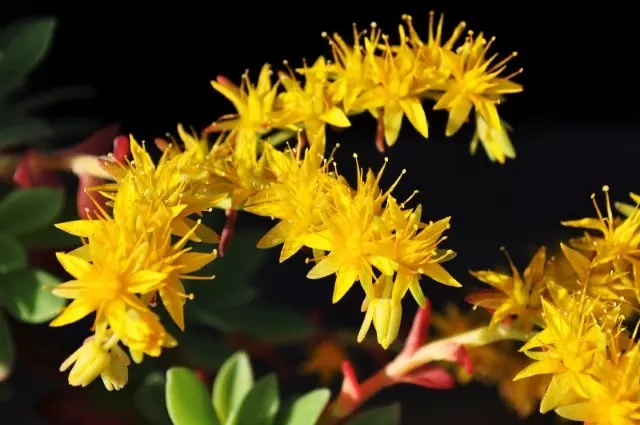
Lithops
Lithops also known as living stones or pebble plants are beautiful succulents that when blooming gives spectacular yellow flowers. They are true masterpieces of nature’s adaptation to the most inaccessible conditions for life in desert areas.
Lithops need to receive 4 to 5 hours of direct sunlight during the first part of the day and partial shade during the afternoon. You can grow it as a houseplant near a window where it can receive enough direct sun, especially in the morning.
A well-drained substrate with high texture and little organic matter. It is not necessary to use fertilizer on Lithops. As all succulents require little watering, too much watering may cause root rot. Learn more about how to care for Lithops.
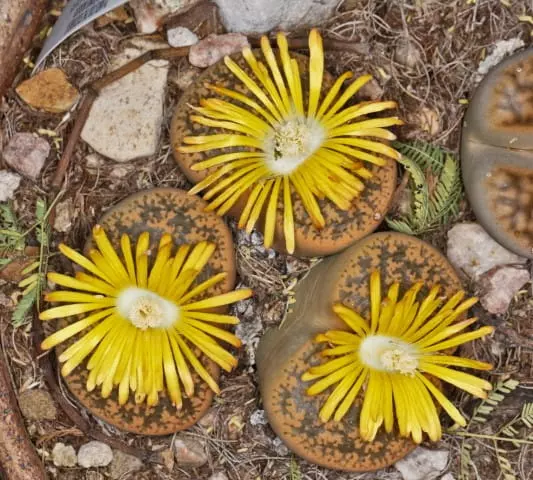
Delosperma congestum
Delosperma congestum is one of the succulents with yellow flowers native to South Africa. This succulent can grow up to 5” (13 cm) high and is found on the mountain slopes of South Africa and Lesotho at an altitude of 11150 ft (3400 meters).
Although this succulent with yellow flowers can be found in the mountains, it only resists light frosts and survives thanks to the direct sunlight it receives. Use a succulent substrate and make sure your pot has drainage holes to allow proper drainage.
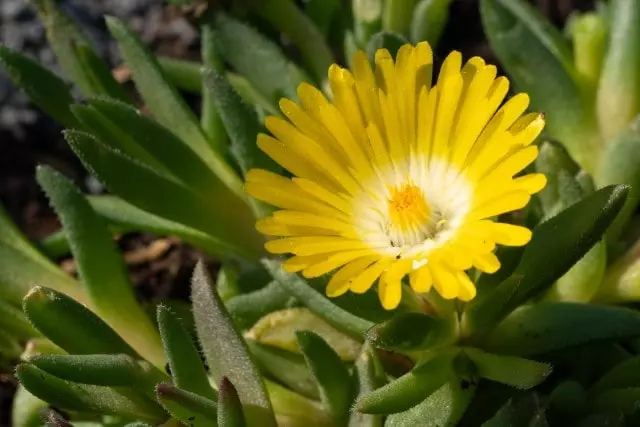
Aloe vera
Aloe vera is a plant of African origin and one of the most prized plants for its medicinal properties. It has more than 350 species and is characterized by its elongated and fleshy leaves that can reach up to 3” (8 cm) thick. Its flowering is very particular and occurs in summer since it grows through an elongated stem.
Aloe vera is a plant that does not need much care. It requires a well-drained substrate and spaced watering, which varies depending on where you place it indoors or in full sun, but can be at least every 10 to 15 days.
This is another succulent with yellow flowers that you can have in your garden and take advantage of its health benefits. I recommend you read our article about the best soil for Aloe vera.
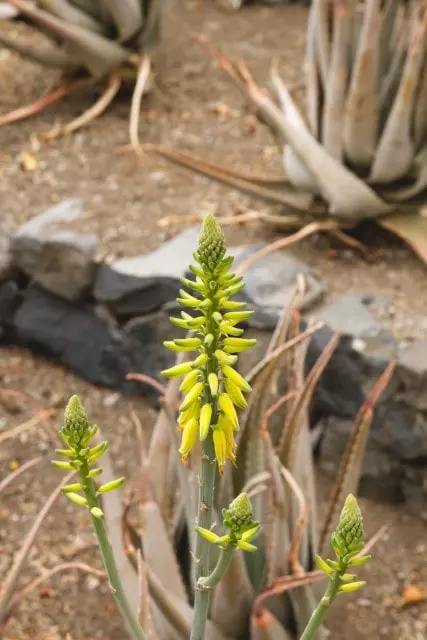
Echeveria
Echeveria is one of the most popular succulent plants. In addition to being extremely beautiful and presenting a good number of varieties, the care of the Echeveria makes it an ideal plant to get started in the cultivation of these plants.
Belonging to the Crassilaceae family, the Echeveria is native to Mexico. An area where it grows regularly in the wild and reaches spectacular dimensions. These succulents with yellow flowers can be grown indoors and outdoors, as long as the winters are not too extreme. If winters are very harsh where you live, I recommend growing Echeveria indoors.
Echeveria needs a lot of sunlight for its development, but if the summer is very extreme it should not receive the midday sun. A well-drained substrate is ideal for this succulent. Water very little as happens with the great majority of succulents. Learn more about the propagation of Echeveria.
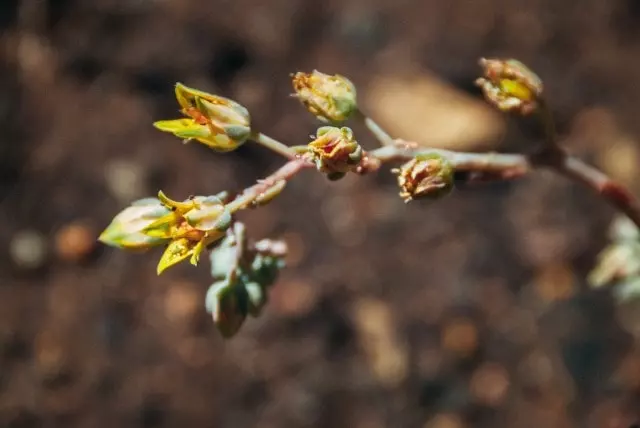
Tree Houseleeks (Aeonium)
Aeonium, commonly known as tree houseleeks is a succulent that when blooming gives beautiful yellow flowers very showy. The genus Aeonium comprises evergreen perennial succulent plants native to the Canary Islands and many parts of Africa.
From the center of the rosette of leaves develops flowers of variable color, from white, green, yellow, or red depending on the species. After flowering the leaf rosette dies, although in the meantime numerous other lateral rosettes will have formed.
Its thick branches can grow up to 40” (1 m) high and give it the appearance of a miniature tree. Aeonium flowers at the end of winter, entering spring. It is a hardy plant that tolerates hot, dry climates, although it prefers “semi-shade” rather than direct sun. Too much direct sun causes the plant to dry out quickly. Learn more about Aeonium kiwi care.
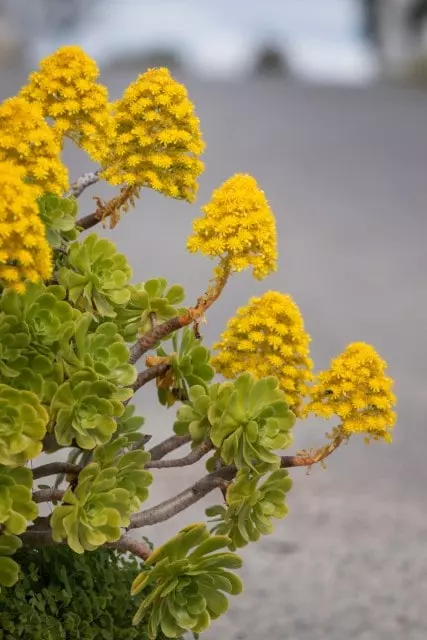
Living Pebble (Conophytum Bilobum)
Conophytum bilobum is a small stemless succulent that develops lobes up to 30” (7.5 centimeters) tall that often produces flowers from the center during fall. These heart-shaped lobes are green and may contain a line of red or violet at the top.
The flowers emerge at the top of the center of the lobes and are yellow or orange. They are unscented and may bloom in autumn and at night, rarely in summer.
This succulent has a regenerative life cycle, that is to say, in the summer it begins its period of inactivity to form a new body inside the old lobes, extracting all its nutrients to leave only the shells of the old lobes.
If you want to know more about these succulents with yellow flowers I recommend you read our article about Conophytum bilobum care and propagation.
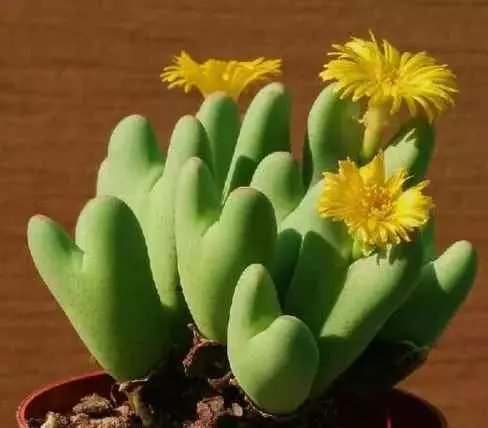
Widow’s-thrill (Kalanchoe calandiva)
Kalanchoe calandiva or Widow’s-thrill is a variety of Kalanchoe blossfeldiana, but double-flowered and a little slower growing. Its leaves are thick and fleshy and its flowers are arranged in bunches or double bouquets of pink, orange, white, red, fuchsia, yellow, and bicolor.
Its flowering is very abundant and extends from autumn to spring in natural flowering, although it can be induced to bloom the rest of the year artificially. Kalanchoe calandiva is an outdoor plant in semi-shade since the direct sun of half a day can damage it. It can also be placed indoors in an area with enough light.
If you want to know more about this beautiful succulent with yellow flowers I recommend you to read our article about Kalanchoe calandiva plant (Widow’s-thrill).
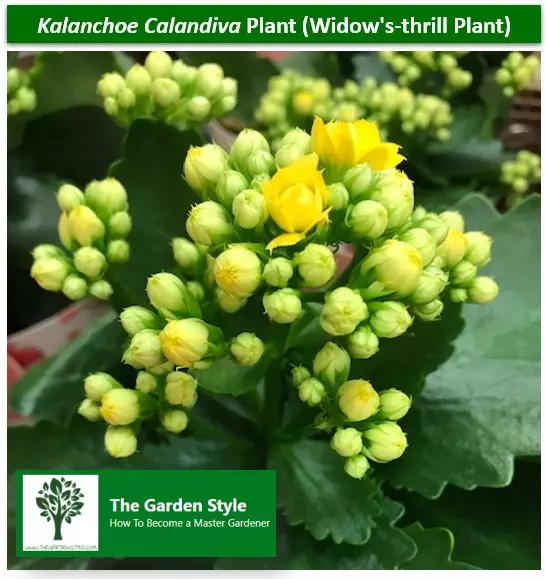
Succulents with Yellow Flowers Video
Below you will see a video where we show all the succulents with yellow flowers mentioned in this article and other extras. Observe the beautiful flowers of these succulents.
Final Conclusions
There are many succulents with yellow flowers and all of them are very beautiful to decorate your home. Some of these succulents require little care and others are a little more demanding but not impossible. One thing I love about succulents is their ease of propagation.
I hope this article is helpful, and that you find a beautiful succulent with yellow flowers that is to your liking. If you know of another succulent with yellow flowers, and you want it to be on this list do not hesitate to contact us. Learn more about how to take care of succulents.
